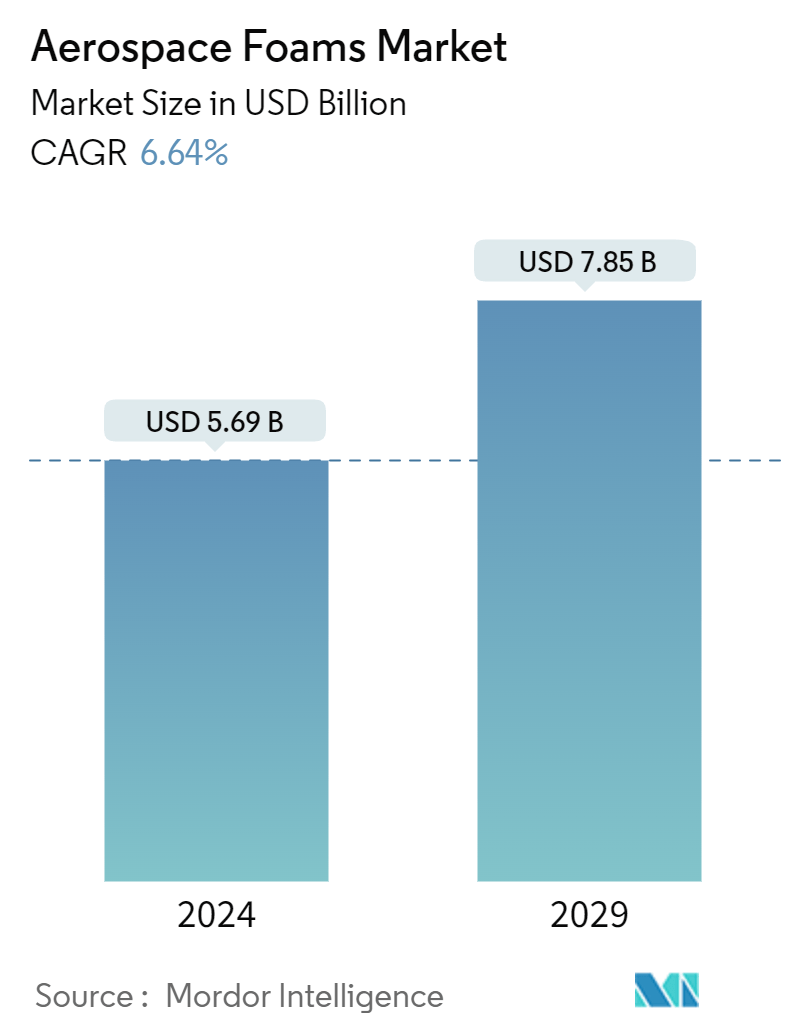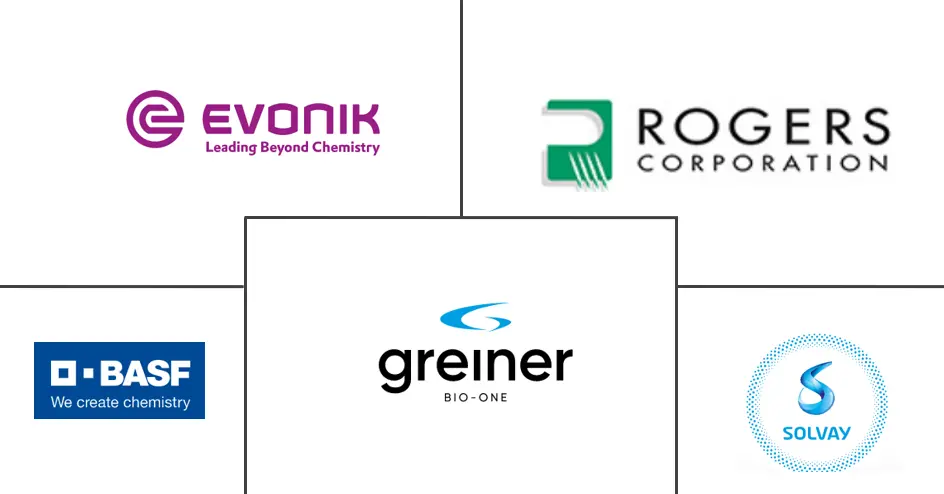Market Size of Aerospace Foams Industry

| Study Period | 2019 - 2029 |
| Market Size (2024) | USD 5.69 Billion |
| Market Size (2029) | USD 7.85 Billion |
| CAGR (2024 - 2029) | 6.64 % |
| Fastest Growing Market | North America |
| Largest Market | North America |
| Market Concentration | Medium |
Major Players
*Disclaimer: Major Players sorted in no particular order |
Aerospace Foams Market Analysis
The Aerospace Foams Market size is estimated at USD 5.69 billion in 2024, and is expected to reach USD 7.85 billion by 2029, growing at a CAGR of 6.64% during the forecast period (2024-2029).
The aerospace foams market plays a pivotal role in the aviation industry, offering essential materials for manufacturing aircraft components that require lightweight, thermally efficient, and acoustically insulating properties. Aerospace foams are vital to enhancing aircraft efficiency, safety, and performance, making them indispensable in the production of interior panels, seating, insulation, and vibration damping components. The increasing focus on fuel efficiency and the demand for lightweight aerospace materials have significantly driven the growth of the aerospace foams market.
Diverse Foam
Types in Aerospace Applications
- Variety of Materials: The aerospace industry employs a range of foams, including polyurethane, polyimide, metal foams, melamine, and polyethylene. Each type is selected based on specific properties suited to particular aerospace applications.
- Polyurethane Dominance: Polyurethane foams are widely preferred for their excellent insulation properties and flexibility, making them ideal for various aerospace applications.
- Metal Foams for Structural Integrity: Metal foams are increasingly chosen for their lightweight characteristics and structural strength, contributing to the overall durability of aircraft components.
- Tailored Selection: The choice of foam material is driven by application requirements, cost considerations, and compliance with stringent aerospace industry regulations.
Geographical Segmentation and Market Dynamics
- North American Leadership: The aerospace foams market is segmented into key regions, including North America, Europe, Asia-Pacific, South America, and the Middle East & Africa. North America, led by the United States, holds a dominant market position due to its extensive aerospace manufacturing base and robust aviation industry.
- European Contribution: Europe, with strong aerospace markets in Germany and the United Kingdom, follows closely behind North America. These countries are significant contributors to the aerospace foams market.
- Asia-Pacific Growth: The Asia-Pacific region is experiencing rapid growth, driven by increasing investments in the aerospace sector and a rising demand for commercial aircraft. This region is becoming a key player in the global aerospace foams market.
Rising Demand for Lightweight and Fuel-Efficient Aircraft
- Fuel Efficiency and Environmental Concerns: The drive for lightweight materials in aircraft manufacturing has intensified, as the aerospace industry seeks to reduce fuel consumption and carbon emissions. Aerospace foams, with their lightweight properties and high performance, are central to this effort.
- Commercial Aviation Focus: The demand for lightweight and fuel-efficient aircraft is particularly strong in the commercial aviation sector , where airlines are under pressure to enhance operational efficiency and reduce operating costs. Aerospace foams are increasingly used in seating and interior components, contributing to significant weight reduction.
- Sustainable Innovations: The growing emphasis on sustainability has spurred the development of new foam materials that offer improved recyclability and lower environmental impact. Innovations in foam manufacturing are enabling the production of materials that meet stringent aerospace standards.
- Regulatory Challenges and Adaptation: Despite facing challenges from stringent regulations, particularly regarding polyurethane foams, the market is gradually shifting towards bio-based and eco-friendly alternatives. This transition is driven by the need to comply with environmental and safety standards, although widespread adoption remains in its early stages.
Aerospace Foams Industry Segmentation
Aerospace foam materials are used in flight-deck pads and passenger cabin applications such as seating, overhead luggage bins, galleys, and lavatories, among other uses.
The aerospace foams market is segmented by type, application, and geography. By type, the market is segmented into polyurethane, polyimide, metal foams, melamine, polyethylene, and other types. By application, the market is segmented into commercial aviation, military aviation, and business and general aviation. The report also covers the market size and forecasts for the aerospace foams market in 15 countries across the major regions.
For each segment, the market sizing and forecasts have been done on the basis of revenue (USD).
| Type | |
| Polyurethane | |
| Polyimide | |
| Metal Foams | |
| Melamine | |
| Polyethylene | |
| Other Types |
| Application | |
| Commercial Aviation | |
| Military Aviation | |
| Business and General Aviation |
| Geography | |||||||
| |||||||
| |||||||
| |||||||
| |||||||
|
Aerospace Foams Market Size Summary
The aerospace foam market is poised for significant growth, driven by the increasing demand for lightweight and fuel-efficient aircraft. The market, which experienced a downturn due to the COVID-19 pandemic, is recovering as air travel demand surges. The shift towards bio-based polyurethane foam manufacturing presents new opportunities, while the reliance on petroleum for polyurethane foam production remains a challenge. North America is expected to lead the market, supported by the region's robust aerospace industry and rising military expenditures. The growth in air travel, particularly in emerging economies, is further propelling the demand for aerospace foams as new aircraft are manufactured to meet the increasing passenger and freight needs.
In North America, the aerospace foam market benefits from the United States' large aviation market and fleet size, alongside significant defense spending. The region's commercial aircraft fleet is projected to expand, with substantial contributions from Canada and Mexico's aerospace industries. The market is partially consolidated, with key players like BASF SE, Evonik Industries AG, and Solvay actively investing in new technologies and facilities to enhance production capabilities. These developments, coupled with the growing demand for aerospace foams in various applications, are expected to drive market growth during the forecast period.
Aerospace Foams Market Size - Table of Contents
-
1. MARKET DYNAMICS
-
1.1 Drivers
-
1.1.1 Increasing Demand for Lightweight and Fuel-efficient Aircraft
-
1.1.2 Steady Growth in the Aerospace Industry
-
1.1.3 Other Drivers
-
-
1.2 Restraints
-
1.2.1 Stringent Regulations Regarding the Use of PU Foams
-
1.2.2 Other Restraints
-
-
1.3 Industry Value Chain Analysis
-
1.4 Porter's Five Forces Analysis
-
1.4.1 Bargaining Power of Suppliers
-
1.4.2 Bargaining Power of Consumers
-
1.4.3 Threat of New Entrants
-
1.4.4 Threat of Substitute Products and Services
-
1.4.5 Degree of Competition
-
-
-
2. MARKET SEGMENTATION (Market Size in Value)
-
2.1 Type
-
2.1.1 Polyurethane
-
2.1.2 Polyimide
-
2.1.3 Metal Foams
-
2.1.4 Melamine
-
2.1.5 Polyethylene
-
2.1.6 Other Types
-
-
2.2 Application
-
2.2.1 Commercial Aviation
-
2.2.2 Military Aviation
-
2.2.3 Business and General Aviation
-
-
2.3 Geography
-
2.3.1 Asia Pacific
-
2.3.1.1 China
-
2.3.1.2 India
-
2.3.1.3 Japan
-
2.3.1.4 South Korea
-
2.3.1.5 Rest of Asia-Pacific
-
-
2.3.2 North America
-
2.3.2.1 United States
-
2.3.2.2 Canada
-
2.3.2.3 Mexico
-
-
2.3.3 Europe
-
2.3.3.1 Germany
-
2.3.3.2 United Kingdom
-
2.3.3.3 France
-
2.3.3.4 Italy
-
2.3.3.5 Rest of Europe
-
-
2.3.4 South America
-
2.3.4.1 Brazil
-
2.3.4.2 Argentina
-
2.3.4.3 Rest of South America
-
-
2.3.5 Middle-East and Africa
-
2.3.5.1 Saudi Arabia
-
2.3.5.2 South Africa
-
2.3.5.3 Rest of Middle-East and Africa
-
-
-
Aerospace Foams Market Size FAQs
How big is the Aerospace Foams Market?
The Aerospace Foams Market size is expected to reach USD 5.69 billion in 2024 and grow at a CAGR of 6.64% to reach USD 7.85 billion by 2029.
What is the current Aerospace Foams Market size?
In 2024, the Aerospace Foams Market size is expected to reach USD 5.69 billion.

